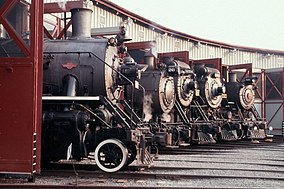Steamtown National Historic Site
| Steamtown National Historic Site | |
|---|---|
|
IUCN category V (protected landscape/seascape)
|
|

Five locomotives in the roundhouse
|
|
| Map of the United States showing the location of Steamtown NHS | |
| Location | Scranton, Pennsylvania, USA |
| Coordinates | 41°24′26″N 75°40′17″W / 41.40733°N 75.67132°WCoordinates: 41°24′26″N 75°40′17″W / 41.40733°N 75.67132°W |
| Area | 62.48 acres (25.28 ha) |
| Established | October 30, 1986 |
| Visitors | 106,309 (in 2005) |
| Governing body | National Park Service |
| Website | Steamtown National Historic Site |
Steamtown National Historic Site (NHS) is a railroad museum and heritage railroad located on 62.48 acres (25.3 ha) in downtown Scranton, Pennsylvania, at the site of the former Scranton yards of the Delaware, Lackawanna and Western Railroad (DL&W). The museum is built around a working turntable and a roundhouse that are largely replications of the original DL&W facilities; the roundhouse, for example, was reconstructed from remnants of a 1932 structure. The site also features several original outbuildings dated between 1899 and 1902. All the buildings on the site are listed with the National Register of Historic Places as part of the Delaware, Lackawanna and Western Railroad Yard-Dickson Manufacturing Co. Site.
Most of the steam locomotives and other railroad equipment at Steamtown NHS were originally collected by F. Nelson Blount, a millionaire seafood processor from New England. In 1964, Blount established a non-profit organization, the Steamtown Foundation, to operate Steamtown, USA, a steam railroad museum and excursion business in Bellows Falls, Vermont. In 1984, the foundation moved Steamtown to Scranton, conceived of as urban redevelopment and funded in part by the city. But the museum failed to attract the expected 200,000 to 400,000 annual visitors, and within two years was facing bankruptcy.
In 1986, the U.S. House of Representatives, at the urging of Scranton native Representative Joseph M. McDade, approved $8 million to begin turning the museum into a National Historic Site. The idea was derided by those who called the collection second-rate, the site's historical significance questionable, and the public funding no more than pork-barrel politics. But proponents said the site and the collection were ideal representations of American industrial history. By 1995, the National Park Service (NPS) had acquired Steamtown, USA, and improved its facilities at a total cost of $66 million.
...
Wikipedia

